We are no longer building saddle trees, but we have two videos about how Western saddles fit horses available on our westernsaddlefit.com website.
Slick Forks
What is a slick fork?
The term “slick fork” classifies a fork that is widest at the bottom where the fork connects to the bars. (A fork that goes wider and then comes in to meet the bars is a swell fork.) It can be any “width” within that limit with narrower forks being called “slicker” than wider ones. They can also come in different stock thicknesses. There have been many names applied to different slick forks over the years, and we use names for slick forks based on stock thickness, but we could just as easily call them all “slick forks” and go with just measurements. Since a slick fork is basically an upside down U, there are two main factors other than minor shaping variations that can vary – “width” and stock thickness.
“Width”
“Width” is in quotation marks because there is no consistent place to measure a slick fork, so the numbers don’t really mean anything. Everyone’s “X width” will be a bit different and you have to go by their pictures to decide what you want to order from each maker. We commonly make forks from 8” (as slick as it can go with our normal attachments) to 10” wide (as wide as it can go without becoming a swell fork) at ½” increments. This applies to the outside outline. The hand hole can change shape and size for fit changes without really changing the outside shape.
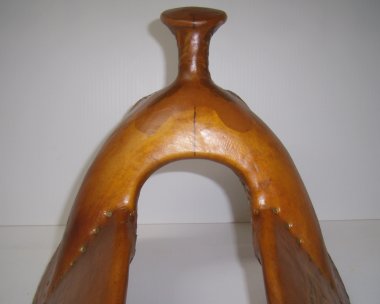 |
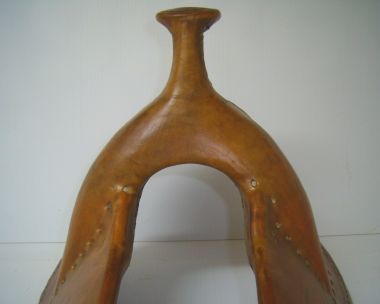 |
| 8" slick fork | 8 1/2" slick fork |
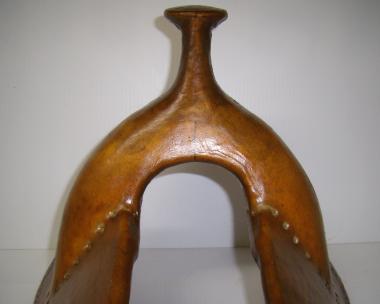 |
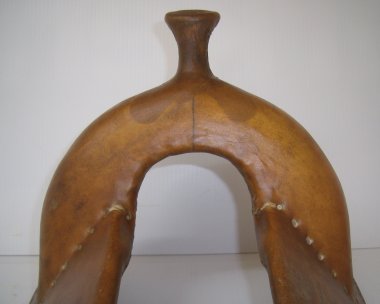 |
| 9" slick fork | 10" slick fork |
Stock Thickness
As discussed in our Measuring a Saddle Tree page, this describes the thickness of the wood, from front to back, that we start with in making the fork. We use three names to describe slick forks, and they are based on the stock thickness. The Weatherly has 3 ¾” stock, the 3B has 4 ¼” stock and the Taylor has 4 ½” stock. (A Visalia 3B has a 3 1/2" stock.) These names are not carved in stone by any means, and we also make other stock thicknesses when requested. The same outline pattern for shape is used for all metal horn slick forks unless you request something different.
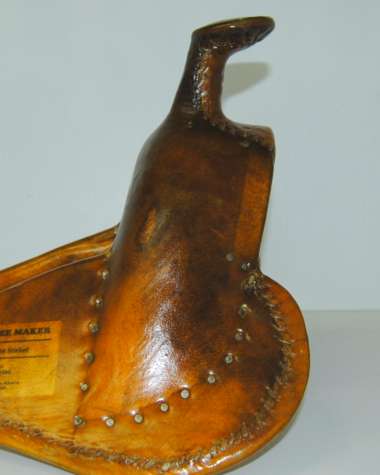 |
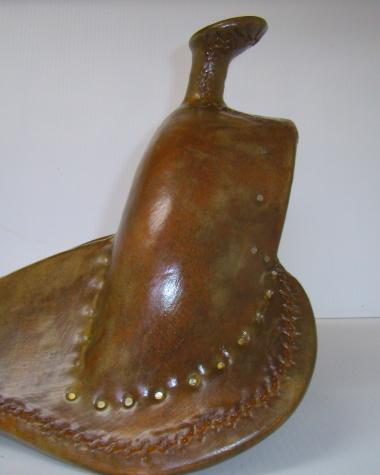 |
| 3 1/2" stock thickness slick fork | 3 3/4" stock thickness slick fork |
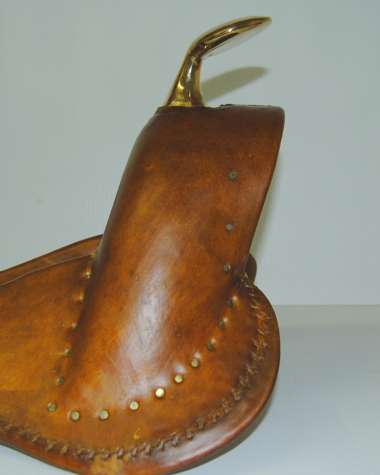 |
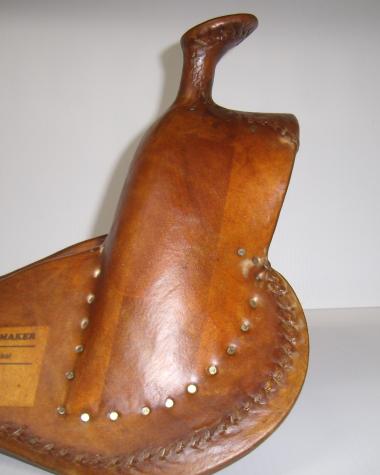 |
| 4" stock thickness slick fork | 4 1/4" stock thickness slick fork |
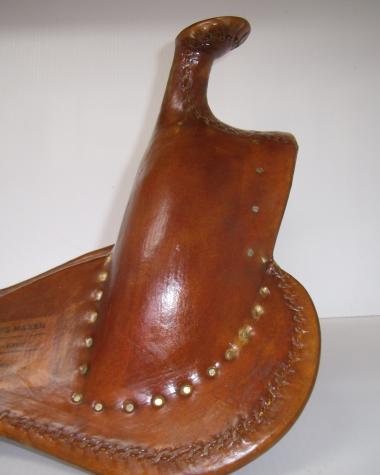 |
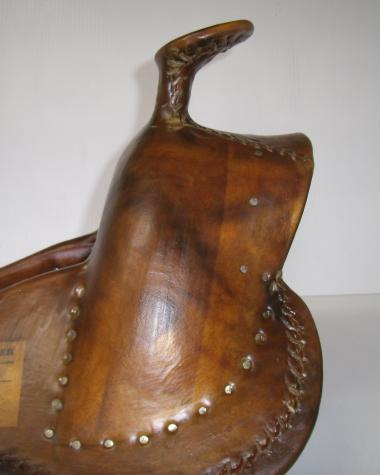 |
| 4 1/2" stock thickness slick fork | 5" stock thickness slick fork |
Top cut angle
The top cut angle is the angle at which the top of the fork is cut relative to the back of the fork. As stock thickness increases, the top cut angle also has to increase to avoid the fork from looking like it is running too far downhill. This factor especially needs to be considered with slick forks because they have more of a range in stock thicknesses than other fork styles. In general, the top cut angle on slick forks is between that used for swell forks, which usually have 3 ¾” stock, and Wades, which usually have 5” stock. As explained in our Avoiding the Withers page, a greater top cut angle will drop the hand hole height for the same gullet height. Most slick forks also have metal horns, which necessitates a thicker gullet than on a wood post horn fork, and therefore also decreases hand hole height relative to gullet height. Narrower stock thickness also drops the hand hole height relative to the gullet height. These are some of the reasons (apart from horse conformation) that the old time saddles had such tall gullets –the gullet lip had to be high to get the clearance they needed at the hand hole. Even today, metal horn slick forks have to be ordered with taller gullet heights to get the same hand hole heights as swell forks or wood post slick forks. Because of the extra low clearance on a 3 ¾” stock Weatherly with the typical top cut angle of a slick fork, we generally use the lower top cut angle that we use on our swell forks. (You can see this in the stock thickness pictures above if you compare the 3 1/2" and 3 3/4" stock thickness trees with the others.) If you want an old time looking narrow stock slick fork, we can use the greater top cut angle, but the gullet height needs to be higher than on a tree with a thicker stock to get the clearance you will need.
Variations in shape
Changes in gullet height will change the top half of the shape a bit, and differences in bar spread and bar angle will affect how far apart the bottom of the fork is spread, so there can be some variation in the look of a “width” of fork. However, we do keep our “widths” consistent across a horizontal line drawn at the bottom of the hand hole when we are marking them out, and the variations are not large unless you compare the extremes. The A to upside down U shape difference within one “width” is due to the amount of “shoulder” the shape has, and we can modify our normal shapes (see pictures above) for you if you request it.
Wood post slick forks
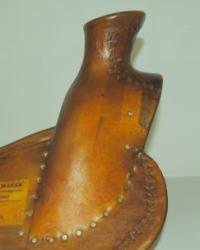
This is where the name game gets you. Is it a modified Wade or a wood post Taylor? Either name could work for the same tree. When you put a wood post horn on any tree, you change the look slightly because you can have less gullet thickness. For practical purposes, we have decided that a 4 ¼” stock thickness slick fork will get the same top and side cut angles as a metal horn slick fork. For greater stock thicknesses, we change to the Wade top and side cut angle and call them Modified Wades. We can change this if you have a specific look you want.
Special requests
How many ways can you make an upside down U anyway? Turns out there are a few things that can be done with the shaping to make them look different, especially when building a tree to look like it came from a previous era. We have also stood them up on occasion and that also makes for a neat, old time looking tree. And fancy horns are always an option.
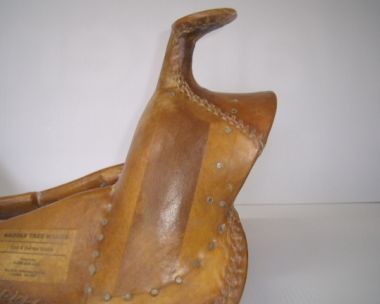 |
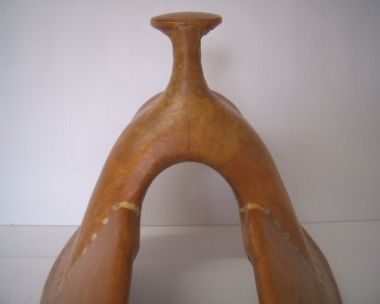 |
| Meanea style slick fork, 5 1/4" stock thickness | Meanea style slick fork, 7" width |
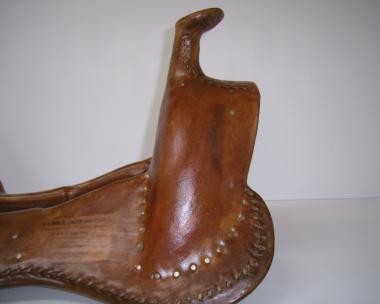 |
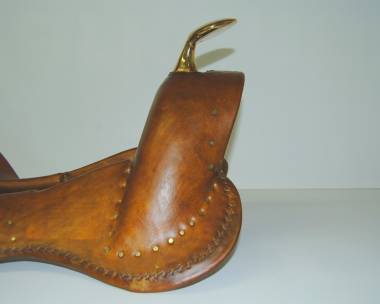 |
| Stood up slick fork | Polished bronze horn on slick fork |
